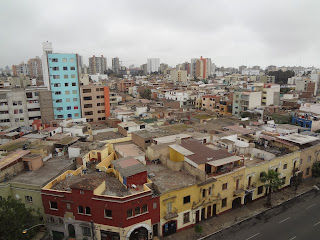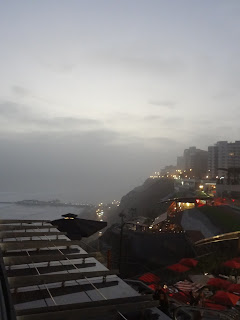After 24 hours on the go, it was great to arrive in Lima and get picked up by Alfred's cousins, Karla and Carlos, who took us back to Karla's place about 20 minutes from the airport. Alfred's mom was from Lima, then lived in Venezuela for a few years before making her way to Los Angeles. While she was in Caracas, her brother Carlos came to live with her, and this is where Karla lived most of her life, and where Carlos was born. Alfred and his mom visited Lima a lot, but never Caracas and their paths had never crossed. So this was the first time Alfred had ever actually met his cousins, and it was very exciting for everyone. Personally, I had a great time talking to the Venezuelans, since its so rare to meet someone who knows anything about Venezuela, and I have been interested to hear the perspective of the people living there about Chavez passing away and Maduro taking over. (But don't worry, Chavez came to Maduro as a little bird at the beginning of the election campaign to bless him, and he's for sure the right guy for the job.)
Karla has been living in Jesus Maria municipality for about four months now. She lives in a 9th floor condo with three bedrooms and great city views, but a lot of chilly wind in the winter. Lima as a "city" would in some ways be better compared to LA as a metro area, including all the cities that lie around the main city. The whole area is split up into municipalities which have their own governing systems and taxes. The whole metro of Lima has 11 million people and is similar in sprawl to a big metro like LA, without many tall buildings until recently, like LA in a lot of surprising ways.
We woke up to a cloudy, cloudy winter day, much like every other day I spent in Lima.
Lima is in the literally the worst place on the entire west coast of South America. The way that ocean currents hit this 150 miles of land keep it at a steady cloudy and humid 62 degrees every single day all winter long, with 57 degree nights. I read in my guide book that the founders of the capital of the Spanish Empire in this region probably arrived in this location in the summer, when its in the 80's and sunny and beautiful every day in Lima and began building. I imagine in the summer the colors and characters of the city come out more brilliantly and fun than in the cold, grey winter.
We spent three days in Lima, visited Alfred's family members and friends, and did some of the tourist things he had never actually done before in his many visits. We began with a bike tour through the most metropolitan areas of the city, by the ocean. Yes, drivers in South America are terrifying, and it took a little bit to get used to the craziness of the city, especially on bikes. The thing I'm not sure I'll ever understand about drivers on this continent is the reasoning behind the honking of the horns. They do seem to signal things, and there is clearly an unspoken consensus for the rules of these streets, but I'd never get into a driver's seat myself there. It's better to just let the taxi driver go, not carry a hot beverage in your hands and not think about whatever it is your used to.
Anyway, on the bike tour, we got to see several huacas, pre-Inca ceremonial structures which sprinkle the city in the 100's. They suddenly rise up behind large cement walls, looking like they are just big piles of dirt, but then you notice they are made of ancient bricks, and you go in for a closer look.
I found myself soaking in as much information as I could about not only the Incas but the cultures that existed here before the Incas took over. The Incas are the most well known because they were the group that the Spanish actually came into contact with (and let's be honest, they were very advanced and facilitating group), but in actuality, the Incas were only in power for about 100 years before the Spanish came along the began taking them down systematically. For thousands of years before this, the rise and fall of highly advanced and interesting groups spotted the Peruvian landscape, and this region is considered one of the breadbaskets of civilization, on par with Egypt and Mesopotamia, with complex and rich cultures rising and existing at the same time.
Lima is built along the ocean, but until about a decade ago, they didn't really use their ocean front for beaches or tourism. Now the city is working on building parks and beaches and accessibility to the great waves and ocean. Here is Miraflores, the most modern, hip municipality to live in right now, where the ocean project is completed. Lima officials are hoping that in a few years the city will also be known as a beach town. Not in their winter obviously, but I hear the swimming is good in the summer.
This is the Parque de Amor, the reason for which is rumored to be too many young people being too public with their displays of affection, promoting city officials to just make a place for them to go do their business in public. There were a handful of couples around this area, too, though I'm not sure how well PDA can be controlled.
This is Larco Mar. The city wanted a new cosmopolitan mall in the fancy Miraflores, but they didn't want to ruin the view from the nearby Marriott and other homes. So they built the mall along the cliff wall. You look at the park across the street and literally have no idea there is a huge, multistory mall full of discotechs and fancy restaurants in front of you, and hundreds of parking spots below you. Suddenly, it drops out underneath you in a flash of bright lights and hundreds and hundreds of people. This is the second most visited place in Peru, after Machu Picchu, of course.
The city center of Lima boasts a Plaza de Armas with a Cathedral (as they all have), the president's home and many federal buildings and hotels. Nearby are several other churches, museums and old winding colonial streets with European-style buildings of all kinds (in some neighborhoods, you'll suddenly see English tutor-style mansions next to more traditions adobe homes.)
This is the church and monastery of San Francisco, a Franciscan monastery. Wish I could have taken more photos, because they have a spectacular library fill of ancient books and huge choir books painted beautifully upon leather, so that they could be turned hundreds of times and the pages wouldn't break. The most interesting part of this church though, were the catacombs beneath, there I was able to sneak one photo:
The bottom of the church was sprawling, filled with piles of the bones of the citizens of Lima, arranged by body part, with a jumble of the smaller bones in a large pile near the door. The only extremely creepy thing about the place was imaging getting stuck down there in the event of an earthquake.
We celebrated the birthday of Alfred's cousins maternal grandmother, and it was great to meet a full family and share VERY sweet wine in toasts, as well as a big cake. Honestly, I felt like I was one of my uncle Dennis' Macalester exchange students, not quite able to keep up with the conversation in another language and letting myself drift a little bit, quietly in the corner, until someone spoke directly to me and asked me questions. Everyone was very kind though, and overwhelming as it was, I had a good night.
Karla, Alfred and I.
Cousins: Alfred and Carlos
Our final day in Lima we visited more of Alfred's family friends, and though it was very interesting to meet people and see more homes of the city, I found myself again quietly overwhelmed trying to understand the Spanish language enough to respond at all. At one of his family friend's houses, we did find some fascinating ancient art, from another pre-Inca society, picked up on a dig by her brother and hung lovingly in her garden.
In my opinion, Lima was interesting, but by far not my favorite city. Maybe in the summer, I would have liked it more. The clouds make the sprawl and grime (its a desert city, and it's hard to escape the layer of dirt on everything) and the honking cars and cold humidity seem rather unbearable. Have I mentioned the food yet, though?! The food in Peru, and Lima in particular, is actually VERY good, with lots of fusion and more Chinese take out places than America. At this point in the trip, I had not had a single stomach problem, which for me is huge. All in all, though, I was ready to move on Cuzco on our very early flight, the destination I was most looking forward to on the trip.














No comments:
Post a Comment